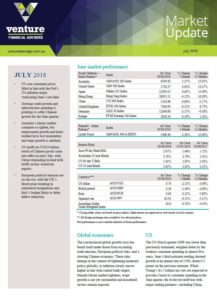
The Pulse
- US core consumer prices lifted in line with the Fed’s 2% inflation target, vindicating June’s rate hike.
- Slowing credit growth and infrastructure spending is pointing to softer Chinese growth for the June quarter.
- Australia’s labour market continues to tighten, but employment growth and hours worked have lost momentum and wage growth is subdued.
- US tariffs on US$34 billion worth of Chinese goods came into effect in early July, with China responding in kind with tariffs on key American exports.
- European political tensions are on the rise, with the UK’s Brexit plan resulting in ministerial resignations and Italy’s budget likely to delay deficit reduction.
Australia
Australian economic growth is on a sound footing, supported by a bounce in global growth, a strong commodities sector, and improved business and public sector investment. However, while there has been a surge in employment and hours worked over the past year, momentum has slowed from 2017’s pace, and wage growth remains subdued at around 2.0%.
Global economies
The synchronised global growth story has found itself under threat from escalating trade tensions, European political risks, and a slowing Chinese economy. These risks emerge in the context of tightening monetary policy globally, as inflation slowly moves higher in line with central bank targets. Despite labour market tightness, wage growth is not yet sustainable and household sectors remain exposed.
US
The US March quarter GDP was lower than previously estimated, weighed down by the weakest consumer spending in almost five years. June’s third estimate reading showed growth at an annual rate of 2.0%, down 0.2 points on the previous estimate. While Trump’s $1.5 trillion tax cuts are expected to provide a boost to consumer spending in the June quarter, the tit-for-tat tariff war with major trading partners—including China, Canada, Mexico and the EU—could prove a drag on growth, putting pressure on supply chains and possibly undercutting business investment.
Europe
Headline inflation in the eurozone rose from 1.9% to 2.0% in June, although this was due mostly to an 8.0% rise in energy prices. Underlying price pressure remains weak, with the core CPI falling from 1.1% to 1.0%.
China
China’s economy continues to show signs of fatigue, with slowing credit growth and infrastructure spending pointing to softer economic growth for the June quarter. June’s official PMI figure showed a further loss of momentum in the manufacturing economy, falling from 51.6 to 51.5, while industrial production also fell 6.9% to 6.8% year-on-year.
Asia Region
Revised GDP data confirmed that the Japanese economy shrank by an annualised 0.6% in the March quarter, putting an end to eight consecutive quarters of growth. This places Japan at risk of a technical recession (defined as two consecutive quarters of negative growth), and while the contraction was caused by temporary factors, a strong rebound appears unlikely.